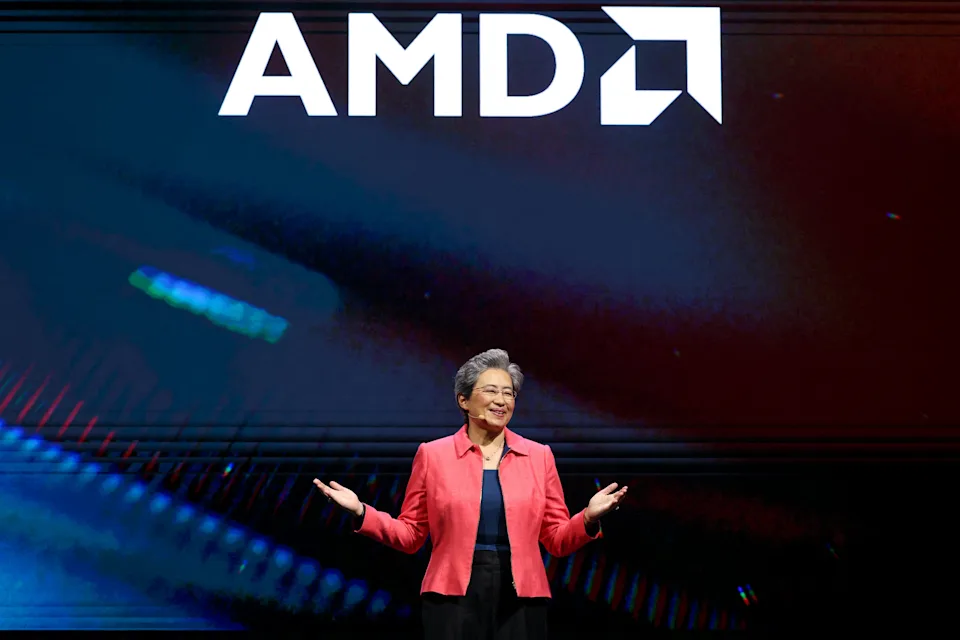Advanced Micro Devices (AMD) reported its Q3 earnings after the bell on Tuesday topped analysts’ expectations on earnings and revenue and provided strong fourth quarter guidance.
The company say it foresees revenue of between $9.3 billion and $9.9 billion. Wall Street was anticipating revenue of $9.21 billion.
AMD stock rose in the immediate wake of the report, then reversed gains to fall as much as 3.5% in after-hours trading.
“We delivered an outstanding quarter, with record revenue and profitability reflecting broad based demand for our high-performance EPYC and Ryzen processors and Instinct AI accelerators,” AMD CEO Lisa Su said in a statement.
“Our record third quarter performance and strong fourth quarter guidance marks a clear step up in our growth trajectory as our expanding compute franchise and rapidly scaling data center AI business drive significant revenue and earnings growth,” she added.
For the quarter, AMD saw earnings per share of $1.20 on revenue of $9.25 billion. Analysts were anticipating EPS $1.17 on revenue of $8.74 billion, according to Bloomberg consensus estimates.
AMD’s data center revenue hit $4.3 billion. Analysts were expecting $4.1 billion. The company saw $3.5 billion in revenue in the same quarter last year.
AMD’s client segment, which includes sales of laptop and desktop chips saw revenue of $2.9 billion versus expectations of $2.6 billion.
AMD’s gaming division pulled in $1.3 billion. Analysts were looking for $1.1 billion.
AMD’s report comes after the company announced a pair of massive AI chip deals with OpenAI (OPAI.PVT) and Oracle (ORCL).
Last month, AMD signed a deal to provide OpenAI with up to 6 gigawatts worth of graphics processing units (GPUs) to power its AI data centers. In turn, OpenAI agreed to purchase upwards of 160 million shares of AMD stock, equal to roughly 10% of the company.
Under its deal with Oracle, AMD will deploy up to 50,000 GPUs across the cloud company’s data centers.
AMD is also providing chips to power two Department of Energy supercomputers at Oak Ridge National Laboratory. The systems will represent a $1 billion public and private investment when completed.
The moves have sent AMD stock rocketing 53% over the past month. Shares are up 108% year to date and 79% over the past 12 months as of Tuesday.
But AMD still trails Nvidia (NVDA), which owns the majority of the AI market and recently saw its market cap cross the $5 trillion mark. AMD’s market cap sits at $418 billion.
OpenAI and Oracle will begin deploying AMD’s next-generation MI450 line of GPUs and rack-scale platforms in the second half of 2026. Rack-scale offerings allow chips to be slotted into large collections of servers to operate as massive computing systems.
AMD’s MI450 chips and rack-scale products, Morgan Stanley’s Joseph Moore wrote in an analyst note, will be an important part of the company’s future growth strategy.
“AMD’s rack-scale solution shipping next year is the key, and we are excited to see what the company can do,” Moore wrote prior to AMD’s announcement.
“It’s still early to make market share assessments, and while the Open AI agreement is clearly an accelerant, the reliance on cloud providers to ramp those 6 gigawatts still creates some uncertainty,” he added. “Ultimately, to drive share gains, the company will need to provide better ROI than [Nvidia] can offer, and customers still raise questions about that given lower rack density and the need to resolve ecosystem issues.”

